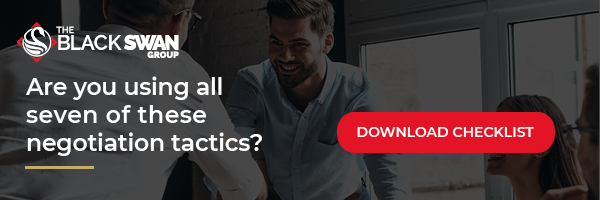One of the most effective methods of persuasion is learning how to say "no". Master this skill to find more success and avoid killing your deals.
“How am I supposed to do that?”
This is from an email I received about two weeks ago:
“I finished reading your book last week--it was a great, entertaining read; I'm planning on buying a few more copies for my employees (whether or not that's a good idea, we'll find out...
I also had my first opportunity to use "...that offer is very generous but I just can't..." and a "how" question, and got a vendor to reduce their fee by 50%, including some non-monetary terms (month-to-month vs. a commitment). I felt like I was using the Force.
So: Thank you!”
The “how” question he used was “How am I supposed to do that?” and what he is referring to before was the application of empathy/appreciation.
“How am I supposed to do that?” is an enormously powerful question that triggers the process we refer to as “reverse empathy”. Reverse empathy is used to put the other side in a position where they have to take a fair look at your position. It makes them think things through.
Using this Method of Persuasion
To use it effectively you need to do three simple things:
- Lead with some form of empathy and deliver with an empathic voice. There’s almost no reason anyone should show you empathy if you haven’t shown it first. Be the first mover here and gain that advantage. Use a kind, even deferential voice. The power of deference is ridiculous.
- Ask “How am I supposed to do that?”
- Shut. Up.
Many people step on great use of the skills by continuing to talk. This is one of those cases where you need to let silence work for you. After you use this question, shut up.
I recently had someone send me an email, and like most emails, they wanted to put all their brilliant negotiation skills into one email. This is like trying to lay out all 7 of your next chess moves in advance and then expecting the other side to just go along with it. Bad idea.
His “How am I supposed to do that?” was buried in the middle of the third of 5 paragraphs. Easy for me to ignore, so I did.
“How am I supposed to do that?” has to be the last thing you say or write and then you have to wait for their response.
"Because you have to."
In the theater of our imagination, which often takes us hostage, the response we anticipate getting is “Because you have to.” As a point of fact, that is actually where you want to end up because that tells you you’ve pushed as far as you can on that issue. One of my USC students had to ask it twice to get to that point when negotiating a lease of a luxury home in the Hollywood Hills of LA. The first “How is my client supposed to do that" was met with a concession. The second was “Well if your client wants to live there you will pay that amount.”
This question doesn’t receive an angry response or a break-off in the negotiations because you are using reverse empathy.
This is from an email I received from a fellow professional teacher:
“Recently a (headquarters bureaucrat) tried to dismantle a program I created and have run successfully for years. He expected me to accept a transfer, reporting to someone three rungs down from my current position. Instead of freaking out, I've been using some of your techniques, especially the all-purpose "How am I supposed to do that?"
Thanks to you the transfer is now dead, though when negotiations started he insisted it was a done deal.”
Harness the power of “How am I supposed to do that?” Let it work magic for you.
Make it rain!

